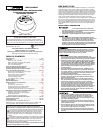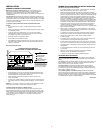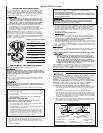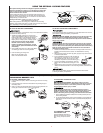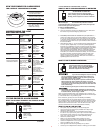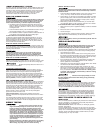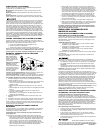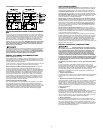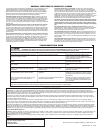
6
“SMART INTERCONNECT” FEATURE
This Alarm includes "Smart Interconnect" which enables the Alarm to be
interconnected with other BRK Smoke, Heat, and "Smart Interconnect"
CO Alarms. When smoke is detected, all Alarms will sound the smoke
horn pattern. When CO is detected, "Smart Interconnect" Alarms will
sound the CO horn pattern. Alarms that do not have the "Smart
Interconnect" Feature will remain silent during a CO alarm.
USING THE SILENCE FEATURE
N
EVER disconnect the power to your Smoke/CO Alarm to silence the
horn—use the Silence Feature. Disconnecting the Smoke/CO Alarm
removes your protection! If the unit will not silence or if it stays in
silence mode continuously, it should be replaced immediately.
• The Silence Feature is intended to temporarily silence the horn
while you identify and correct the problem. Do not use the Silence
Feature in emergency situations. It will not correct a CO problem
or extinguish a fire.
• To use the Silence Feature, press the Test/Silence button until you
hear the acknowledge “chirp” or until the horn is silent.
• If the Test/Silence button is pressed while the Smoke/CO Alarm is
in the silence mode, the alarm will start sounding again.
To silence Alarms in an interconnected series:
To silence an interconnected series of Smoke/CO Alarms, you must
press the Test/Silence button on the initiating alarm (The unit with the
flashing red light; the red light will be off on all other Alarms.). If you
press the Test/Silence on any other Alarm, it will only silence that unit,
not the whole interconnected series.
WHEN THE SMOKE ALARM IS SILENCED...
The Smoke Alarm will remain silent for up to 15 minutes and then return
to normal operation. If the smoke has not cleared within the silence peri-
od or if smoke increases to a critical level during the silence period, the
unit will go back into alarm.
Use the Silence Feature only if you are certain of the source of
smoke. If you are not certain of the source or a fire starts while
you are clearing smoke, evacuate the house immediately. Not
responding to an alarm can result in property loss, injury, or death.
WHEN THE CO ALARM IS SILENCED...
The CO Alarm will remain silent for 4 minutes. While the Alarm is
silenced, it will continue to monitor the air for CO. After 4 minutes, if CO
levels remain potentially dangerous the horn will start sounding again.
The Silence Feature is intended to temporarily silence the Alarm horn. It
will not correct a CO problem.
LOW BATTERY SILENCE FEATURE
This Silence Feature can temporarily quiet the low battery warning
“chirp” for up to 8 hours if AC power is present. Press the Test/Silence
button on the Alarm cover until you hear the acknowledge “chirp”.
Once the low battery warning “chirp” silence feature is activated, the
unit continues to flash the green light once a minute for 8 hours. After 8
hours, the low battery “chirp” will resume.
The Alarm will continue to
operate as long as AC power is supplied. However, replace the battery as
soon as possible, to maintain protection in event of a power outage.
THE “LATCHING ALARM” INDICATOR:
The Latching Alarm Indicator is activated after an Alarm is exposed to
alarm levels of smoke or carbon monoxide. This feature will only work
with AC power. After smoke or CO levels drop below alarm levels, the
red smoke or CO LED will begin to flash once every 5 seconds. It will
continue to flash or “latch” until you clear it by testing the alarm.
This feature helps emergency responders, investigators, or service
technicians identify which unit(s) in your home were exposed to alarm
levels of smoke or carbon monoxide. This can help investigators
pinpoint the source of smoke or CO.
Interconnected Alarms. Latching Alarm Indicator shows which
Alarm(s) in the series were exposed to alarm levels of smoke or carbon
monoxide.
The Latching Alarm Indicator stays ON until you clear it, so it can alert
you to an alarm that occurred while you were away from home, even
though smoke or CO present in the air has dropped below alarm levels.
WEEKLY TESTING, Continued
It is important to test this unit every week to make sure it is working
properly. Using the test button is the recommended way to test this
Smoke/CO Alarm.
1. Push and hold the Test/Silence button on the cover until you hear a
“chirp.” The “chirp” marks the start of the self-test sequence.
2. During testing, you will hear a loud, repeating horn pattern: 3 beeps,
pause, 3 beeps, pause, while the red smoke LED flashes. Then you
will hear a loud, repeating horn pattern: 4 beeps, pause, 4 beeps,
pause, while the red CO LED flashes.
3. When testing a series of interconnected units you must test each
unit individually. Make sure all units alarm when each one is tested.
If the Smoke/CO Alarm does not test properly:
1. Make sure the AC power is applied and battery is fresh and installed
correctly.
2. Be sure the alarm is clean and dust-free.
3. Test the unit again.
If the Smoke/CO Alarm is still not working properly, replace it immedi-
ately. Refer to the “Limited Warranty” at the end of this manual.
If there is still a problem, do not try to fix the Alarm yourself. This will
void your warranty!
REGULAR MAINTENANCE
Use only the replacement batteries listed below. The unit may not
operate properly with other batteries. Never use rechargeable
batteries since they may not provide a constant charge.
This unit has been designed to be as maintenance-free as possible, but
there are a few simple things you must do to keep it working properly:
• Test it at least once a week.
• Clean the Smoke/CO Alarm at least once a month; gently vacuum
the outside of the Smoke/CO Alarm using your household vacuum’s
soft brush attachment. Test the Smoke/CO Alarm. Never use water,
cleaners or solvents since they may damage the unit.
• If the Smoke/CO Alarm becomes contaminated by excessive dirt,
dust and/or grime, and cannot be cleaned to avoid unwanted
alarms, replace the unit immediately.
• Relocate the unit if it sounds frequent unwanted alarms. See “Where
This Alarm Should Not Be Installed” for details.
• When the battery back-up becomes weak, the Alarm will “chirp”
about once a minute (the low battery warning). This warning should
last 7 days, but you should replace the battery immediately to con-
tinue your protection.
This Alarm must have AC or battery power
to operate. If AC power fails, and the battery is dead or missing,
the Alarm cannot operate.
DO NOT spray cleaning chemicals or insect sprays directly on or near
the Alarm. DO NOT paint over the Alarm. Doing so may permanently
damage the Alarm.
CHOOSING A REPLACEMENT BATTERY:
Your Smoke/CO Alarm requires one standard 9V battery. The following
batteries are acceptable as replacements: Duracell #MN1604, (Ultra)
#MX1604; Eveready (Energizer) #522. You may also use a Lithium
battery like the Ultralife U9VL-J for longer service life between battery
changes. These batteries are available at many local retail stores.
Actual battery service life depends on the Smoke/CO Alarm and the
environment in which it is installed. All the batteries specified above
are acceptable replacement batteries for this unit. Regardless of the
manufacturer’s suggested battery life, you MUST replace the battery
immediately once the unit starts “chirping” (the “low battery warning”).
WHAT YOU NEED TO KNOW ABOUT CO
WHAT IS CO?
CO is an invisible, odorless, tasteless gas produced when fossil fuels do
not burn completely, or are exposed to heat (usually fire). Electrical
appliances typically do not produce CO.
These fuels include: Wood, coal, charcoal, oil, natural gas, gasoline,
kerosene, and propane.
Common appliances are often sources of CO. If they are not properly
maintained, are improperly ventilated, or malfunction, CO levels can rise
quickly. CO is a real danger now that homes are more energy efficient.
“Air-tight” homes with added insulation, sealed windows, and other
weatherproofing can “trap” CO inside.
WEEKLY TESTING
• NEVER use an open flame of any kind to test this unit. You
might accidentally damage or set fire to the unit or to your
home. The built-in test switch accurately tests the unit’s
operation as required by Underwriters Laboratories, Inc. (UL).
If you choose to use an aerosol smoke product to test the
Smoke Alarm, be certain to use one that has been Listed to
Underwriters Laboratories, Inc. Safety Standards, and use it
only as directed. Use of non-UL Listed products or improp
er
use of UL Listed products may affect the Smoke Alarm’s sen-
sitivity, and may void your warranty.
NEVER use vehicle
exhaust! Exhaust may cause permanent damage and voids
your warranty.
• DO NOT stand close to the Alarm when the horn is sounding.
Exposure at close range may be harmful to your hearing.
When testing, step away when horn starts sounding.



